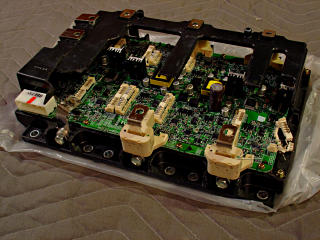
This is the main Integrated Power Module, or IPM, that drives the motors. Control electronics on the visible board drive large IGBTs underneath. The boosted positive and battery negative connect to the power rails of the IGBT bridge pairs, and motor U/V/W emerge from the side terminals and route upward toward where the MG1 and MG2 connections take off. The large off-white plastic assemblies around the connector straps are motor current sensors.
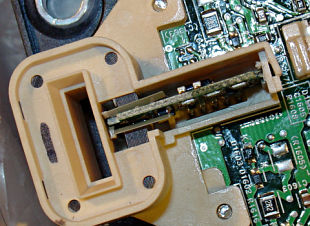
One of the current sensors with the little snap-on lid removed. The V and W leads have these; the current for the U connection can be deduced by the fact that the motors have a simple Y connection and the three currents must sum to zero. These are full Hall-effect modules, not AC current transformers, so they can indicate DC current levels in either direction. It's also easy to see how the board is conformal-coated over most of its surface [which also makes part numbers that much harder to read].
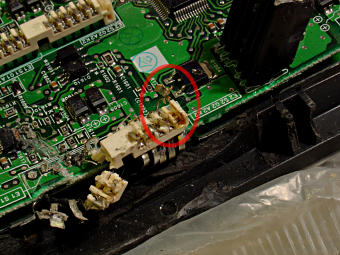
The "loose" IPM got fairly damaged in transit; the board is actually bent down and cracked in this area. With a multilayer board like this, it's probably way past ever fixing. Fortunately the one in the inverter is still intact. Here we can see one of the many white connector blocks that go down to the gate and other leads of the power transistors. These aren't connectors that can be unplugged; they all appear to simply be terminal points where soldered connections are made. One [circled] has been lifted so far, revealing no simple way to disconnect these in bulk.
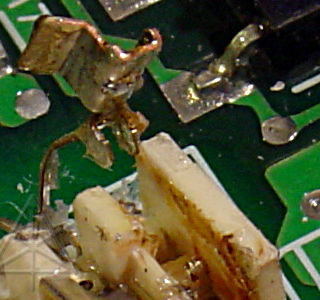
Which implies that if the board is going to come off the power-transistor plate, every one of these has to be desoldered. This is a multi-step process -- they were likely originally done in parallel, after the board was seated down and all the transistor leads simply poked up through the holes in each of these lugs. Now, since this board is relegated to demo status, it's easier to heat each one and pull it up until the two little retainer barbs come completely out of the plastic, allowing the lug to bend back clear of the pin.
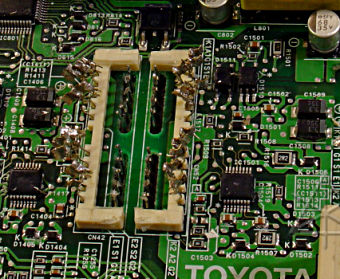
Some time later, all the lugs are finally desoldered and the retaining plastic broken clear from around the pins, and the board is free to lift off ...
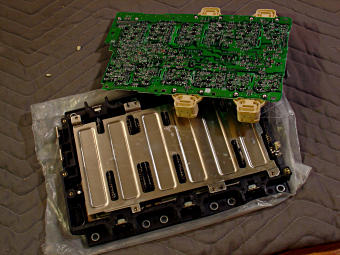
... revealing a shielding plate underneath.
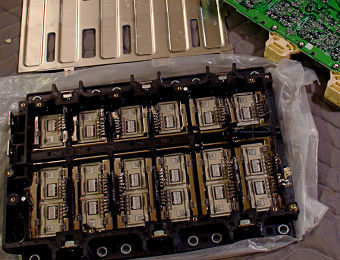
And after *that* is lifted off, we see the power transistor array. This is a view of electronics we usually only see when looking at highly magnified pictures of transistor and integrated circuit dies -- slabs of silicon and tiny bonding wires spot-welded in place. This is the same type of construction except it's on a scale easily viewable with the naked eye -- these things are HUGE, and have multiple parallel bonding wires for high current capacity.
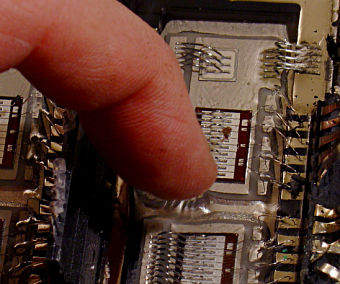
But the weirdest part is the layer of clear silicone potting goop that they're all buried under. This stuff really has to just be *experienced* to be believed. It's quite sticky but returns right down to its original layer when poked and released, and is absolutely clear and very flat on the surface which is why it's so easy to photograph through it. It doesn't migrate or flow at all; if it did, the mounting angle of the inverter would have caused it to all pile up at one edge. Oak Ridge possibly first brought all this to light and has some pictures in 890029.pdf, but seeing and feeling the real thing here really drives home how it's constructed.
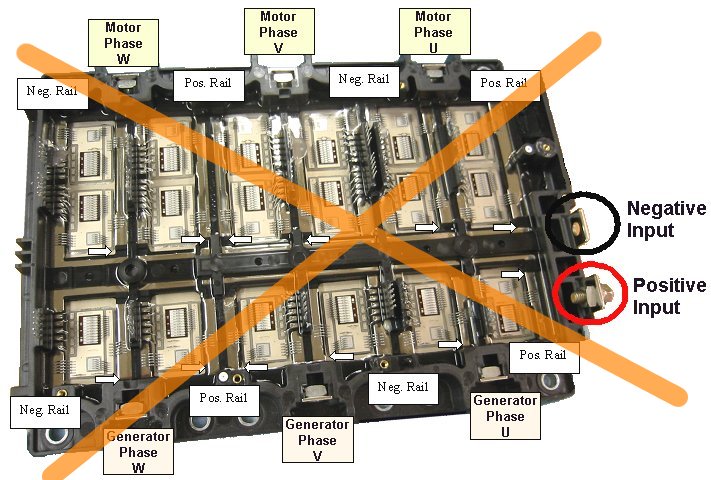
The IGBTs for MG2 are doubled up for even higher current handling, and simply connect in parallel. This is Oakridge's determination of the overall power routing -- except that they got it WRONG, reversing the positive and negative.
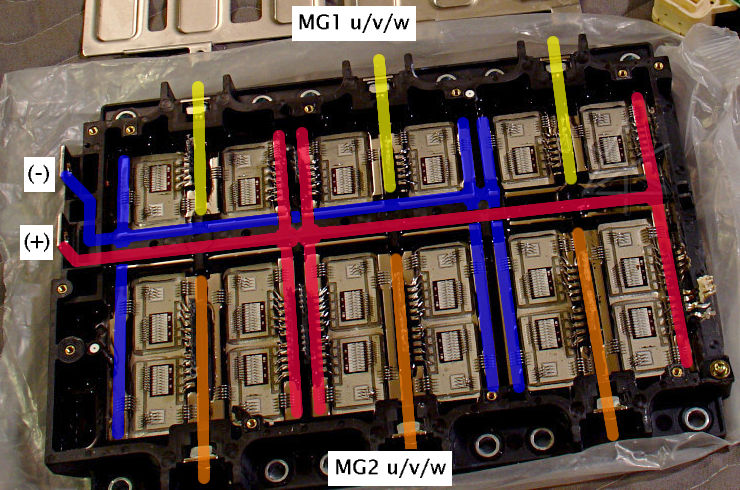
Here's how things are really connected inside the module. The control connections are always at the *collector* end of the transistor block; all the V-phase devices in the center are flipped upside down to make the rail routing simpler. The rails are all embedded down in the plastic and the routing is not obvious simply by looking at them.
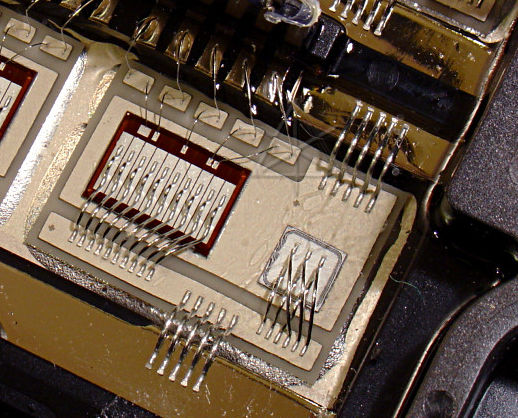
One of the transistor/diode pairs up close and personal. The wires to the control leads are surprisingly light and delicate -- they don't have to handle a lot of current, but you'd think a little more physical robustness would be desired in something that will later have potting compound poured into it. The power bonding points, on the other hand, are heavy, numerous and spread out to make current density through the devices as uniform as possible. Sprinkled randomly around the whole IGBT array are little bonding-wire straps bridging various points in the collector areas -- there's one visible in the big version of this picture and several more in the ORNL shot above. Their locations are unstructured enough that my best guess would be post-construction workarounds for layer nonuniformity, when test currents created hot spots and revealed possible die defects. Heat and thermal runaway will obviously be this thing's worst enemy -- well-proven by some of the early device failures during Prius development, which is why so much attention is paid to removing it and why Toyota had to give up on off-the-shelf parts and develop their own IGBTs for the purpose.
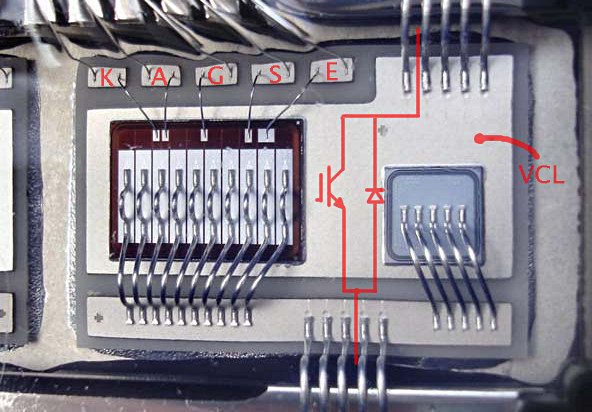
In fact, the design has evolved over time. In particular, compare the diode in this one, from ORNL's early '04 car, versus the previous from this '05 inverter -- a minor design change clearly happened in the interim, adding one more bonding wire and changing the pattern across the anode pad. Here, by the way, the leads have been labeled and the [correct!] equivalent circuit overlaid. There was a discussion on the Prius_Technical_Stuff yahoogroup about some of this, and "toyolla2" offered the best explanation for the five control leads: I believe we may be looking at the world's largest SENSFET ! Motorola's tradename for the device which is able to indicate the current that's flowing in it. They are used for motor control when current sensing resistors become impractical due to dissipation and Ldi/dt issues. An extra mosfet transistor is formed on the same die as the main device, thus it models the exact same current as the main device except that it has an die area 1/10000 the size and takes that fraction of main current. A resistor of 200 ohms is connected from the source terminal S of this transistor which is brought out. Also brought out is the Kelvin terminal, which I think is terminal E and goes to the emitters of the bipolar output transistor right on the die so that lead resistance and the accompanying offset voltage are avoided. These two terminals usually feed into a differential amplifier. The MC34129 current mode PWM chip interfaces quite well to these devices so you might find a tech bulletin on this chip to explain it more fully. Sensfets have five legs, this has seven. I think K and A are a diode being used as a die temperature sensing device. In addition, the collector die from the MG1 U lead is brought out in a sixth lead called "VCL", which one surmises simply monitors the common high-side collector voltage which should closely equal the positive rail. In general, given the currents flowing through this assembly, it's clear that careful attention has been given to detecting unusual voltage-drops through the interconnects.
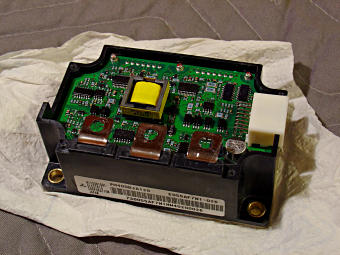
Next, we move on to the boost-converter module. This drives the large inductor next to it to raise the 220 or so battery volts up to as high as 500, to increase efficiency and available top speed of the motors. The faster a permanent-magnet motor spins, of course, the more voltage it generates to fight the power supply which self-limits speed at a particular voltage. This is another IPM, similar in construction with a large heat- sink plate underneath, heavy connections on the top, and a control-lead plug in the side.
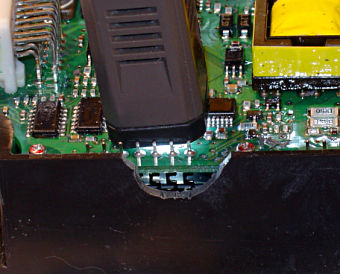
Trying to back out the screws holding the board down is, surprisingly, rather futile. They either spin without coming out, or are in so tight that I wound up stripping the heads in the somewhat cheezy metal they're made of. To try and find out what was going on and if it's worth continuing, a small cut has been made with a Dremel tool down past the board edge, and shining a light through everything shows rather interestingly serpentine interconnect wires. Again, hard-soldered in and no convenient connectors, implying another arduous disconnection job.
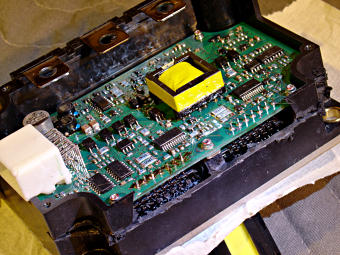
Finally, the entire front of the box is cut away, but despite that, still no hints as to why the screws are, well, so screwed up. Efforts [with somewhat primitive tools at hand, the solder-sucker I *know* I have cannot be found anywhere, argh] to desolder nicely aren't working well, so in disgust all the interconnects simply get sliced and bunch of other nasty brute-force stuff you really don't want to hear about happens in here.
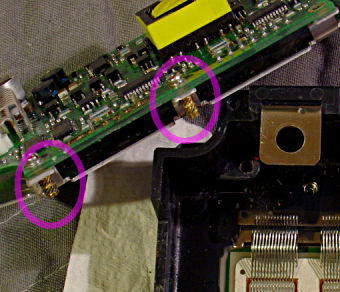
*Now* we see why the screws wouldn't come out. Those stupid brass thread inserts were poorly installed, and wound up just spinning in their holes. Anyway, with the thing opened up at last we see very similar construction -- a thin shield layer under the driver board, and more power transistors submerged in silicone goop. ORNL also provided this detail, and hopefully had better luck getting the thing apart.
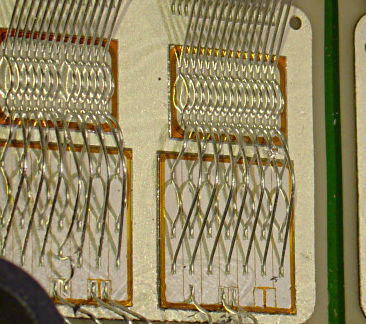
These transistors are even bigger! Schematically this module has two power IGBTs, but they're again doubled up with parallel pairs. Where currents tend to divide up through motor leads in the inverter IPM, this module has to occasionally handle the full 100 amps available from or to the battery and possibly much higher peak currents while doing boost switching, and it shows. Even more attention is paid to bonding layout and sheer number of wires. It's interesting that the members of each pair are connected slightly differently, with an additional tap extended right from the emitter to one of the sense pads on one, and a separate connection on the other. There's probably a good reason behind that too, making every effort to sense conditions right down at the device level.
_H* 070530